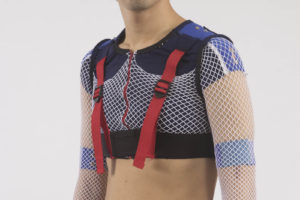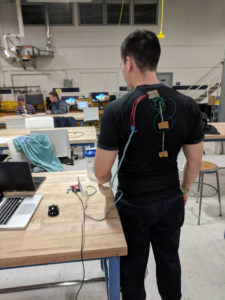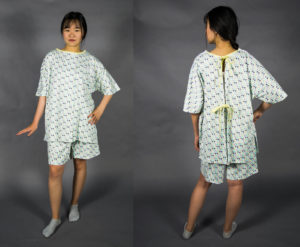2018 Advanced Textiles Student Design Competition Winners Announced
Advanced Textile Products and the Narrow Fabrics Institute, divisions of the Advanced Textiles Association (ATA), recently selected the winners of the 2018 Advanced Textiles Student Design Competition. The awards were announced during IFAI Expo 2018, held in Dallas, Texas, Oct. 15-18.

First place: The Intra-spacesuit Electromyography Garment, created by Walter Lee, Stephanie Wang and Caroline Albers from the University of Minnesota.
First Place
First-place honors went to J. Walter Lee, Stephanie Wang and Caroline Albers from the University of Minnesota, for their Intra-spacesuit Electromyography Garment.
The project is a non-invasive, textile-based wearable system that can be used for measuring muscle activations of the body inside a spacesuit or any other rigid, small compartment where optical research methods are not viable. The purpose of the design is to assist researchers in addressing musculoskeletal injury risks for astronauts, which are common during spaceflight and during training on earth.
Second Place
Megan Cavellier from Central Michigan University took second prize with her ReCover Hospital Gown, intended to address the special needs of teenagers, who can be very self-conscious about what they wear, even in the hospital. The new design provides teens with a sense of dignity, along with physical and emotional safety.

Third place: the Posture Monitoring Smart Shirt, created by Jeremy Doody, Marjorie Pickard, Joshua Gvillinsky and Jaime Shimra Fine from the University of Rhode Island.
Third Place
Third prize was awarded to Jeremy Doody, Marjorie Pickard, Joshua Gvillinsky and Jaime Shimra Fine from the University of Rhode Island, for their Posture Monitoring Smart Shirt. The smart technology-enabled compression shirt uses integrated sensors to continuously monitor an individual’s posture, and can monitor complex movements—it can even detect when someone is bending over or lifting objects in a potentially compromising way. Wearers can track their posture though a Bluetooth-connected smartphone application, to possibly prevent some back injuries from occurring, and to improve treatment if they do occur.
This year’s Advanced Textiles Student Design Competition challenge was to use textiles as a major component to design aerospace, medical, military, safety/protective or other wearable and nonwearable textile technology applications. ATA and its divisions have created student design competitions to encourage students to pursue careers in the specialty textiles field. Students compete for a prize package worth more than $6,000, including a trip to IFAI Expo, to present their winning projects and spend time with industry members from all parts of the textile supply chain. For details about ATA and its divisions, visit www.textiles.org.











